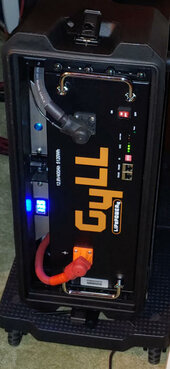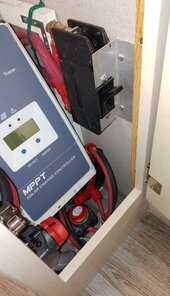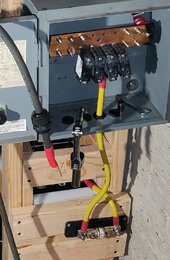You are using an out of date browser. It may not display this or other websites correctly.
You should upgrade or use an alternative browser.
You should upgrade or use an alternative browser.
House burned down
- Thread starter Jejochen
- Start date
Brucey
Solar Wizard
Its an MNEDC 250They provide the same protection as a T class?
I'm sure you've mentioned it somewhere in this thread but I didn't see it. In your use case, which specific Midnite DC breaker are you using? Link if you're feeling generous!
It has an AIC rating of 50,000A at 125V. This particular one has a delay of 16:

42OhmsPA
What's in a title?
That's the route I took and I'm very glad I did.You're allowed to have a fuse and a breaker. Breakers are very handy for taking a battery offline if required.
Note, this rack pictured will be rebuilt with steel and skinned in cement board when I expand and add another 690Ah.
Have you looked at the specs for Midnite / Carling Tech breakers? MNEDCI'm of the opinion, and I'm in the minority, that breakers are so bad at the over current part that it's actually more dangerous to have them in the mix. I'll take a disconnect and a fuse. I don't want the disconnect trying to do the fuse's job.
"MidNite's Breakers Are Rated To Break The Full Rated Load At The Rated Voltage Repeatedly, With NO DAMAGE. Always Use A Properly Sized Breaker For Disconnecting.
All MidNite Circuit Breakers Can Be Used At 100% Rated Current When Mounted In A MidNite Enclosure."
Link if you're feeling generous!
Attachments
Brucey
Solar Wizard
There was a nice metal battery cabinet available on Amazon I forget where the link was.I'm seriously reconsidering using a DIY wood ended box. On all metal shelves that I intend on putting metal doors on, but... hm.
hwy17
Anti-Solar Enthusiast
I have more respect for Midnite breakers than any other. Those are vetted for the purpose.Have you looked at the specs for Midnite / Carling Tech breakers? MNEDC
"MidNite's Breakers Are Rated To Break The Full Rated Load At The Rated Voltage Repeatedly, With NO DAMAGE. Always Use A Properly Sized Breaker For Disconnecting.
But they're just as expensive or more expensive than fuses, so you see less people actually using them, and I'm not personally tempted.
And I don't quite buy the claim of no damage. Every contact suffers damage when breaking DC under load, it's just a matter of how many times they can do it. I like that my contactors are straightforward about that and it's in the data sheet.
Brucey
Solar Wizard
Some reviews showed what folks came up with for mounting solutions:I'd like to see a dielectric object ("insulating busbar") between breaker lug and shunt. Or a least a longer negative jumper.
Right now they can pivot to touch. Are those unprotected, straight from battery?
How about a panel?
Ideally, square knock-out in metal, with holes for the screws.
Maybe just two rectangular pieces, one for top and one for bottom. After mounting, cover with two more rectangles to keep fingers out.
Typical breaker panel bezels have twist-out pieces leaving a square hole, probably not the right dimensions.
I haven't used any bezel mount yet, only plug-on or DIN rail.


Brucey
Solar Wizard
Alte store had them on sale for $47 each so I picked up a few, less than a class T when you take the fuse holder into account.I have more respect for Midnite breakers than any other. Those are vetted for the purpose.
But they're just as expensive or more expensive than fuses, so you see less people actually using them, and I'm not personally tempted.
Couldn’t agree more. In a 5k-50k total setup cost, a few hundred bucks could literally be life savingI'm taking all three conclusions:
1. Class T Fuses
2. Cells in metal boxes
3. 5 side FR4 separation
robby
Photon Vampire
- Joined
- May 1, 2021
- Messages
- 4,203
I could not agree more, that's why I did all three.I believe both reported fires share a suspicion of a lack of separator.
I'm taking all three conclusions:
1. Class T Fuses
2. Cells in metal boxes
3. 5 side FR4 separation
Having the whole electric room a safe distance from the House is the way to cover the unknown possibilities.
hwy17
Anti-Solar Enthusiast
Power shed is definitely the ultimate goal and the hardest to attain. When I ran my ground mount conduit I also ran a 1"conduit half way as preparation to build one there some day. Then I can dig up my PV conduit and bring it up into the shed, and send power to the house through the 1".I could not agree more, that's why I did all three.
Having the whole electric room a safe distance from the House is the way to cover the unknown possibilities.
robbob2112
Doing more research, mosty harmless
I am skeptical of the fuse being the initial cause, based on the fact that this happened at night with very low currents.
My though is, it could have been a cell that internally shorted, caught on fire and the fuse blew after the fire had already started melting things, one thing falls on top of another, etc.
Everyone is running out, pointing fingers, and changing out their fuses...the thing I'd like to point out is that every devastating fire I've seen on this forum was using raw cells. Not a single one I can recall use pre-built batteries that were fully contained in metal boxes holding smaller quantities of cells within. I'd argue that the metal boxes are what slow down and often times smother out the fires - Seplos makes some and I think they just make sense if you insist on DIYing your batteries.
suggested this earlier

House burned down
This really sickens me to hear about the OP’s loss. I’m glad no one was physically harmed. I’d be a bit pessimistic about the actual cause, because the fire could definitely obliterate it. The fuse, though not my favorite shouldn’t have caused the problem. The fact that it happened at a low...
Ampster
Renewable Energy Hobbyist
The only issue I have with that analysis is that spontaneous combustion for what ever reason is highly unlikely with LiFePO4 chemistry. It it more likely with NMC or LIPO. I agree with the thought that we do not know what the reason for the fuse to melt and that is the big question? This system did have 100 kWhs of capacity so that is a lot of energy accross that kind of fuse.My though is, it could have been a cell that internally shorted, caught on fire and the fuse blew after the fire had already started melting things, one thing falls on top of another, etc.
Hedges
I See Electromagnetic Fields!
- Joined
- Mar 28, 2020
- Messages
- 21,056
Think he said it was one of the fuse-per-string.
Could be backfed, don't know how much voltage drops for a bad cell (several bad cells?) or how much current they will accept - is that enough to blow a fuse?
If the fuse blew while batteries were venting, that explains it.
How the fire re-ignited after being extinguished, I don't know. Thought that was only a thing for the other chemistries.
Could be backfed, don't know how much voltage drops for a bad cell (several bad cells?) or how much current they will accept - is that enough to blow a fuse?
If the fuse blew while batteries were venting, that explains it.
How the fire re-ignited after being extinguished, I don't know. Thought that was only a thing for the other chemistries.
Quattrohead
Solar Wizard
When I got serious about running my home with batteries, I dumped the wood boxes and went metal case.I'm seriously reconsidering using a DIY wood ended box. On all metal shelves that I intend on putting metal doors on, but... hm.
Also there are perfectly good breakers for DC, you just can't buy them on Amazon for $20.
robbob2112
Doing more research, mosty harmless
So,
Reviewing this thread the OP had 7 strings of 16s 280ah cells completed in 2020

 diysolarforum.com
diysolarforum.com
Still using the batrium BMS with 112 top of battery balancers. Using multiplus II 3k in 3-phase configuration.
Using Mega 200amp fuses per the victron manual. I assume 70mm^2 cables also per the manual.
Shelves were glassy smooth per the OP.
Earlier when I mentioned venting followed by over current followed spark of any sort either from burning fuse holder or by the hydrogen or other by product reaching combustion temperature. This is pure speculation on my part but I honestly don't think we will ever know the actual cause unless the victron data shows something.
Reviewing this thread the OP had 7 strings of 16s 280ah cells completed in 2020

LFP Powerwall
a few pictures of my own built 'home energy system'. I run my house, workshop and if needed charge my tesla model S with it. currently 3 multiplus 2 5 kVa units for 3-phase system, 48 V battery: 3 banks of 16 200 Ah cells, monitored by batrium. The victron system runs the ESS template. One of...
Still using the batrium BMS with 112 top of battery balancers. Using multiplus II 3k in 3-phase configuration.
Using Mega 200amp fuses per the victron manual. I assume 70mm^2 cables also per the manual.
Shelves were glassy smooth per the OP.
Earlier when I mentioned venting followed by over current followed spark of any sort either from burning fuse holder or by the hydrogen or other by product reaching combustion temperature. This is pure speculation on my part but I honestly don't think we will ever know the actual cause unless the victron data shows something.
DPC
Solar Enthusiast
Regular 1/2 sheet gypsum board has a fire rating of about an hour.
You can get thicker boards and boards with 4 hour ratings.
I think it might be wise to look into that for a battery room in a wood structure and its not that much more expensive than regular dry wall...
An Ontario electrical code regulation thats since been removed from the code called for 1.2 normal dry wall between wood and electrical services in homes.
I thought this was a good rule.
Its also something to consider, its not a requirement but dry wall is so cheap.
You can get thicker boards and boards with 4 hour ratings.
I think it might be wise to look into that for a battery room in a wood structure and its not that much more expensive than regular dry wall...
An Ontario electrical code regulation thats since been removed from the code called for 1.2 normal dry wall between wood and electrical services in homes.
I thought this was a good rule.
Its also something to consider, its not a requirement but dry wall is so cheap.
I think the important part is that with the pre-built batteries from a reputable manufacturer you also automatically get rid of a lot of the questionable practices that people have done when building raw cell DIY batteries on a shelf. I also wonder about assuming the metal boxes would snuff out the fires when we now have pre-built batteries with fire extinguishers within the metal cases. Lots of unknowns here.Not a single one I can recall use pre-built batteries that were fully contained in metal boxes holding smaller quantities of cells within. I'd argue that the metal boxes are what slow down and often times smother out the fires - Seplos makes some and I think they just make sense if you insist on DIYing your batteries.
Bob B
Emperor Of Solar
- Joined
- Sep 21, 2019
- Messages
- 8,854
It looks to me like this system was build better than most .... and yet his house burned down .... kind of a punch in the gut for DIYers.
Of course Walmart kept having fires in their commercial solar systems too.
I'm glad everyone was OK and also glad the OP posted this .... I should result in a lot of soul searching a renewed emphasis on safety.
Of course Walmart kept having fires in their commercial solar systems too.
I'm glad everyone was OK and also glad the OP posted this .... I should result in a lot of soul searching a renewed emphasis on safety.
Seplos, apexium, luyuan, EEL, are some common ones. Apexium are made by Docan. I have EEL that are supposed to be Seplos clones. Some will let you customize to spec with breakers, fuses, etc. I believe @Steve_S got some real nice luyuan boxes doneSomeone recommend me a case for Eve 230Ah cells plz... heh
Last edited:
Similar threads
- Replies
- 90
- Views
- 10K
- Replies
- 12
- Views
- 863



